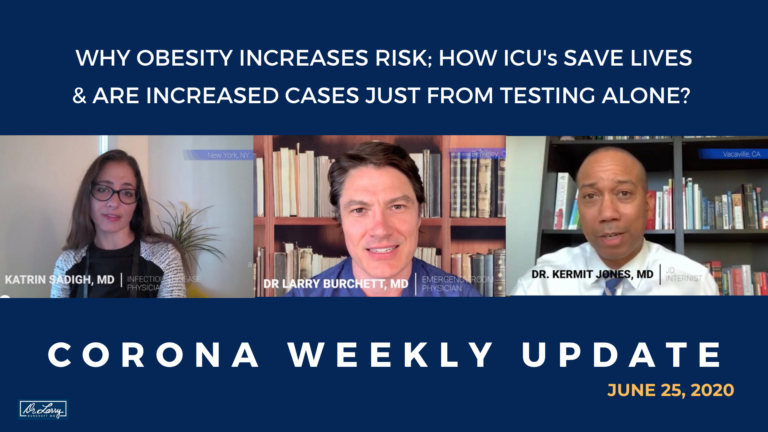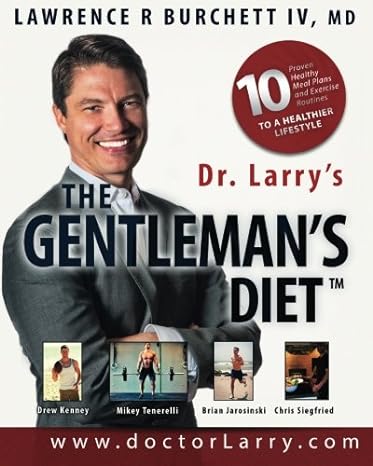Why Obesity Increases Risk; ICUs Saves Lives; Case Increase From Testing?

SUMMARY: June 25, 2020
- Why Obesity Increases Risk?
- How ICUs Save Lives?
- Are Increased Cases Just From Testing Alone?
CASE NUMBERS
LARRY BURCHETT
Globally, we saw a million new cases, for a total of 9.6 million cases worldwide–that’s 2 million in 2 weeks, or about 20% of all COVID19 cases during the pandemic. It included 33,000 new COVID19 deaths, for a total of half a million COVID19 deaths
At home, the US added 216K new COVID19 cases last week, bringing the American total to 2.5 million total cases.
In early June, the daily new cases were around 15K, but this week, late June, that doubled to 30K a day.
The peak levels seen in April, with:
- California spiking to over 7,000 daily cases
- Texas to over 5,500
- Florida to over 5,500
- And 24 other states also seeing a sharp rise
The good news: 14 states are flat and 12 are declining. Those hit hardest in April may have some level of herd immunity or taking masks and distancing seriously.
Cases have spiked, but deaths have not.
As you can see, cases are clearly going up, is that just from increased testing?
In March, for example, as we tested more, the % positive went down. But in the last 2 weeks testing hasn’t changed much (around 500,000 daily), yet the % positive went up from 4.5 to 5.5 %. Now, how can increased testing explain that, when testing hasn’t increased? It can’t, and this increase most likely means infections (not testing) is on the rise.
So cases are increasing 30,000 daily, but the total daily deaths at 700/day now are down from 2,700 – May 6.
Will this spike lead to deaths? Maybe not, if more of the cases are young people.
Remember, most deaths have been in folks over 65, in nursing homes, often with multiple medical conditions. It seems likely that new infections are more young now, as the young reopen the economy and the old continue to shelter.
So we can focus on the following data, with the hypothesis, if young people are now more of the infections, then we might expect to see less ICU admits on vents, quicker time to recovery, and perhaps, more transmission to older contacts.
A word of caution for the young: COVID19 can still be dangerous to the young, especially those with obesity, diabetes and pregnant.
COVID AND OBESITY
KERMIT JONES
Although 3 in 4 deaths are older people, the young are not immune. Let’s talk about one of the key risk factors: obesity.
What’s obesity? Medically, it means your body mass index is over 30 kg / m2. Or body fat, for adult men, is over 25% and, for women, over than 33%.
An example: it’s a 6ft tall person who weighs over 220 lbs.
It’s widespread in America. About 40% of young people, 20 to 40 years old, are obese. And 45% of people aged 40 to 60.
How does obesity connect to COVID19? If you’re obese and infected, you’re more likely to be in the hospital, become critical, and even die.
A New York University study of 3600 COVID19 patients found that obese patients were twice as likely to be hospitalized.
A Johns Hopkins study of 265 COVID19 patients found the young people who end up in ICUs tend to be obese.
This confirms what we saw during the 2009 H1N1 flu pandemic, studies found that up to one third of hospitalized patients or fatal cases of H1N1 were in obese patients.
Why would obesity make COVID19 more severe? There are two complications to your respiratory system:
- First, fat around the waste, referred to medically as adipose tissue, sits beneath the diaphragm, making it harder for the lungs to expand, oxygenate blood and remove carbon dioxide.
- Second, these fatty adipose tissues release inflammatory chemicals called cytokines that cause low levels of constant inflammation and stress the immune system.
What can you do to better protect yourself? Bottom line we should all wear masks, socially distance, and avoid large gatherings. If you are moderately overweight, you should talk with your doctor about additional precautions. Even if your state’s open, try to continue working from home, and get tested as soon as you see symptoms.
CRITICAL CARE
KATRIN SADIGH
With cases up, all eyes are back on Intensive Care Units, or ICUs, where we send patients whose basic organ functions are failing. ICUs have more intense monitoring and advanced life support like ventilators. ICU doctors and nurses are skilled at treating a patient at this critical state, with an arsenal of interventions different from those in non-ICU settings.
While a regular hospital ward may have 1 nurse per 5 patients, an ICU may have 1 nurse per patient.
When COVID19 cases spiked in NYC, many hospitals struggled to find enough beds and ventilators, skilled providers, and masks and gloves.
Once hospitals run out of capacity, the death rate climbs quickly because we can’t give critical patients adequate care. We have to “triage” and make difficult decisions about who lives and who dies.
The good news since then:
We’ve learned early interventions to keep patients off ventilators including high-flow oxygen therapy and putting patients on their stomachs to improve lung function.
We have more protective equipment, learned to sterilize and reuse masks, and produced more ventilators.
Bottom line: if you end up in a well-equipped ICU, you have a better chance of survival.
The bad news
Hospitals are filling up. Alabama and Arizona are at 84% capacity. In North Carolina, Duke Hospitals are 93% full.
Texas Medical Center is now at 100% capacity in their ICUs. Only yesterday, the hospitals’ CEOs were expressing concern over climbing numbers, while today they are reassuring the public that they’re ready to respond to the surge.
If this spike doesn’t flatten, many hospitals won’t have room for patients.
The virus is spreading to rural hospitals lacking proper equipment. We learned how to move equipment around some NYC hospitals. That’s harder between towns far from a city or airport.
Over the next 2 weeks, we’ll pay close attention to how this rise in cases affects our ICUs.
More studies to come.
- https://www.cidrap.umn.edu/news-perspective/2020/04/new-york-obesity-appears-raise-covid-19-risk
- https://hub.jhu.edu/2020/06/01/david-kass-obesity-covid-19/
- https://www.thelancet.com/journals/lancet/article/PIIS0140-6736(20)31024-2/fulltext#sec1
- https://www.ncbi.nlm.nih.gov/pmc/articles/PMC6523028/
- https://pubmed.ncbi.nlm.nih.gov/20518797/
- https://pubmed.ncbi.nlm.nih.gov/27486196/
- https://www.khou.com/article/news/health/coronavirus/texas-hospital-icus-crowded-with-covid-19-patients-as-coronavirus-continues-to-spread/285-aad0788d-256e-4454-8e3f-87f9c7956680


